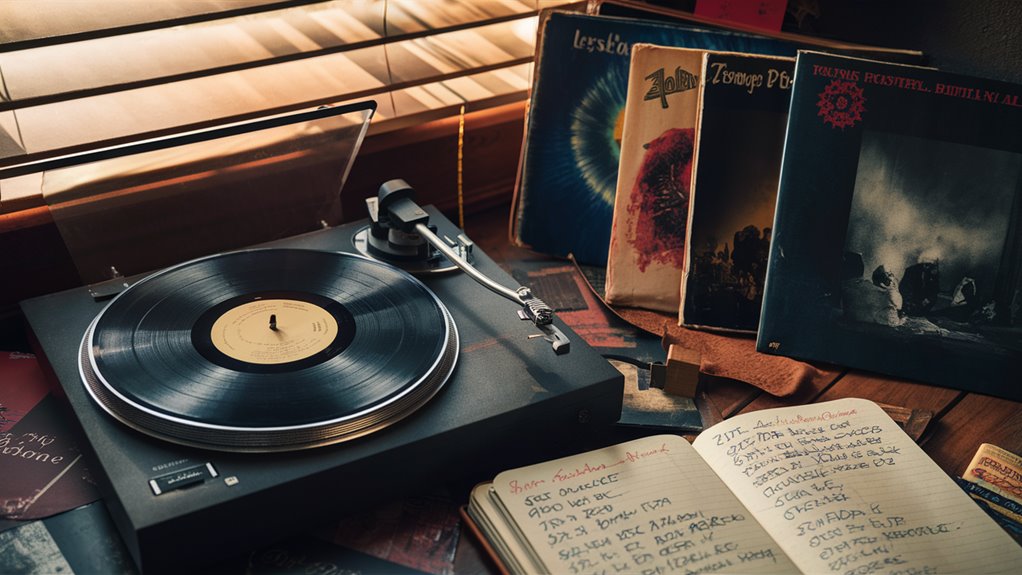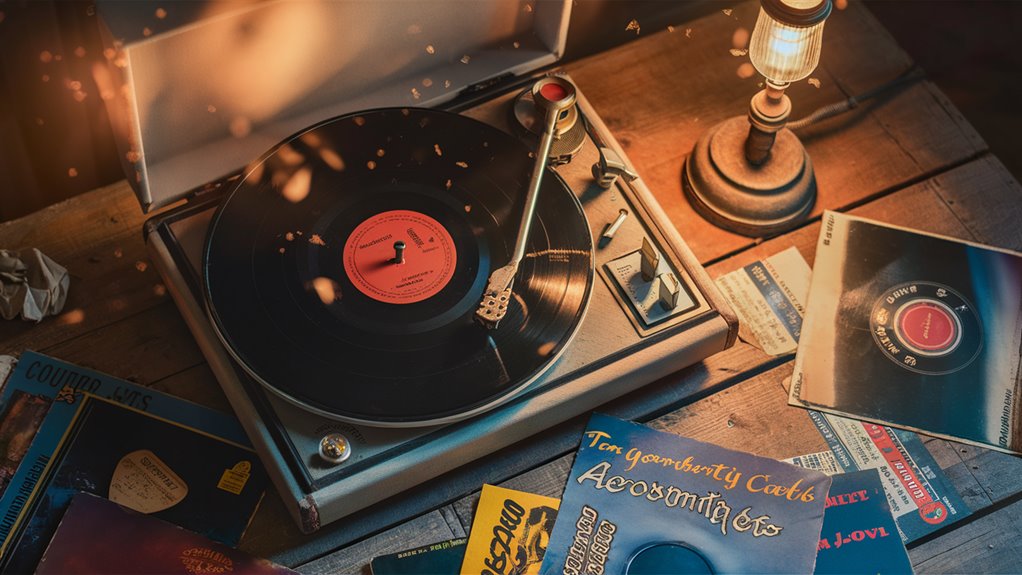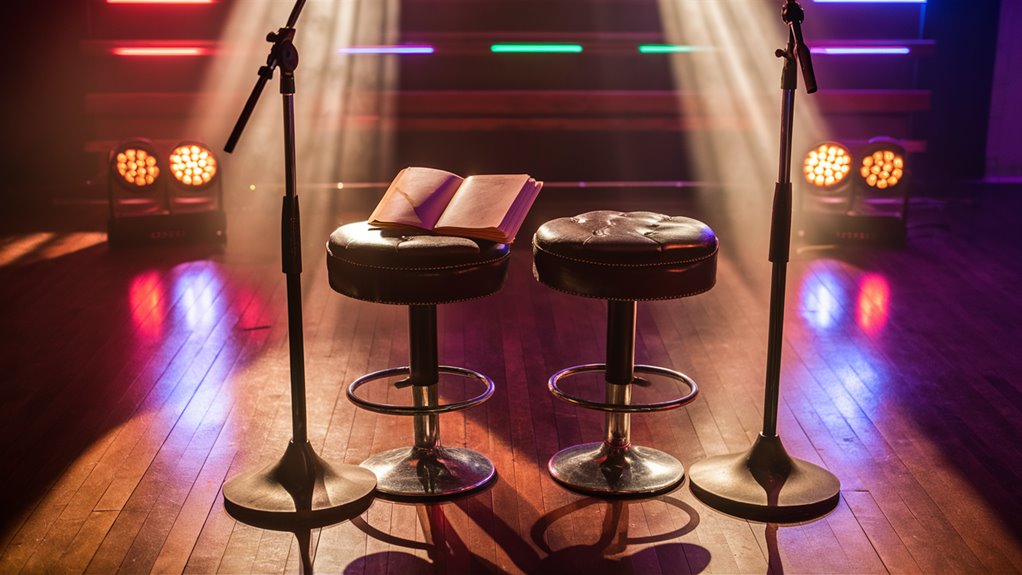Easy Guide to Solo Recording Setup
Basic Mic Setup
Big mics are key for good solo recording. Put your mic 6-12 inches from what you’re recording using a cardioid setup for the best sound grab. Add a pop filter 2-3 inches from the mic to block pops.
Technical Must-Haves & Signal Flow
Link with a USB sound interface that has 48V power. Set up sound treatment well:
- Panels at first echo spots
- Bass traps in corners
- Diffusers for even room sound
Basics of Sound Processing
Use these main settings for clean audio:
- Low-cut filter at 80Hz
- Compression of 3:1
- Keep sound tops between -18dB and -12dB
How to Monitor
Listen to your recordings with closed-back headsets that have:
- Direct sound monitoring on
- Sample rates at 44.1kHz or 48kHz
- No delay in sound monitoring
Making Your Room Sound Right
Make a great recording space with:
- Good sound treatment
- Smart mic setup
- Low room echo
Must-have Solo Recording Gear
Main Recording Parts
A great solo recording starts with a big mic. This main part catches all sounds of voices and tools well.
A USB sound interface with good inputs and power connects the mic to your computer.
Gear for Setting up the Mic
Putting the mic right needs a strong stand for the best setup and steadiness.
Put a pop filter to cut out sharp pop sounds while you sing.
Good cables keep the sound clear all through the setup.
Listening and Software
Headsets that cover ears help you hear well and block sound leaks while you record.
Use pro sound software like Pro Tools or Logic Pro X for recording and fixing sound.
Make sure your computer can handle many tracks at once.
Keeping Room Sound Good
Sound panels really boost your recording quality.
Put foam panels at echo spots to manage room sound.
Shocks for the mic stop shakes from ruining your record. Place these just right for a fine recording spot.
All Needed Gear Checklist
- Big mic
- USB sound interface with power
- Strong mic stand
- Pop filter
- Good cables
- Headsets that cover ears
- Pro sound software
- Sound panels
- Mic shocks
Set Up Your Sound Room Just Right
Make Your Pro Sound Room
Get Room Sound Fine
Sound treatment is a must for pro sound. Set up soft panels at echo spots and bass traps in corners to cut bad echo and flutter.
Keep your sound setup 3 feet from walls to cut early echoes that change your sound.
Mic Setup and Spot
Putting the mic right really changes how good your sound is. Have your mic on a firm, still stand at the right height.
For voice recording, set the mic even with your head and tip it up a bit. When recording tools, line up the mic with the main sound spot.
Put a pop filter 2-3 inches from the mic to cut plosives.
Keep Your Recording Spot In Check
Listen with headsets that cover ears to keep sound just right. Keep sound gains low with peaks between -18dB and -12dB for enough space in sound.
Use a reflection screen to cut room sound in not treated spots. Make a great recording spot by stopping noisy gear and turning off air systems to keep sound clean.
The Basics of Sound Software
Basics of Using Sound Software (DAW)
Main Parts of DAW
A Sound Software (DAW) is the main tool in modern sound spots.
The main screen shows three big parts: the arrange window, mixer, and control bar. The arrange window shows sound tracks from left to right, while the mixer shows sounds up and down for sound level changes and effect paths.
Way to Move and Controls
Know these key shortcuts for fast work:
- Record (R key)
- Play/Stop (Spacebar)
- Loop, click track, tempo at the control bar
The DAW works with both MIDI and sound recording with live monitoring through your sound in-face.
Set Sound Settings
Sound Settings
Make your DAW run well by setting these main things:
- Buffer Size: 256 bits suggested for recording
- Sound Rate: 44.1kHz or 48kHz are usual choices
- Check Input: Turn on for direct mic hearing
- Sound Gain Check: Look at input levels
These settings make a firm base for pro sound and mixing in your Sound Software.
Modern Mic Sound Ways
Must do for Spot and Signal Journey
Good mic spot is key to get clear sound.
Keep a 6-12 inch gap between the source and mic for a mix of near sound feel and room air.
For voice recording, a bit off side mic placement cuts plosives but keeps high sound clear.
Choosing Good Mics
Cardioid mics are top for studio work, with the Shure SM7B and Neumann TLM 103 as top picks.
Link through top amps like the Scarlett 2i2 or UA Apollo, keeping good sound gain at -18dB space.
For live tools, the XY sound way with pairs of small mics gives top results.
Keep an Eye on Sound and Quality
Check the sound flow through pro headsets as you record to catch unwanted sounds or phase issues.
Well-covered wires and good grounding cut noise in the sound chain.
Sound treatment with right mic ways gives studio-like records and cuts work later.
Ways to Think On for Recording
- Manage close sound effect
- Make phases line up
- Control room sound
- Max sound over noise level
- Match bits
- Optimize amp gain
Mix Your Solo Show
Top Tips to Mix Your Solo Show
Start Your Mix Steps
Clean sound grab sets the ground for solo recordings that sound pro.
Start your mix by using these key steps for studio-like results.
Key EQ and Cutting
First, use a low-cut filter at 80Hz to drop low sound bits you don’t want.
Then use exact equalizing on select sound parts:
- Cut at 250Hz to clear muddy sound
- Boost at 3kHz for more feel
- Lift high at 10kHz for air and shine
Keep Sound Even and Compress
Right compress ways keep sound levels even:
- Use FET compress for voice
- Put VCA compress on live tools
- Set at 3:1 with slow start
- Aim for 3-4dB less sound
- Try side compress at 70/30 dry/wet mix
Add Depth and Echo
Add depth with care through space work:
- Put echo with 1.8-second fade
- Cut sounds below 100Hz in echo return
- Keep 15% wet/dry mix for clear sound
- Keep space depth while keeping real sound feel
These mix ways will make your solo show shine with a clean, pro sound that keeps the true feel of your first recording.



